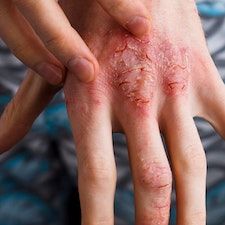Article
Increased Risk of Venous Thromboembolism Identified in Individuals with Atopic Dermatitis
Author(s):
New data indicating this connection suggests a need for clinicians to take into account cardiovascular examination for patients with both the skin disorder and symptoms suggestive of incident venous thromboembolism.

There is an increased risk of incident venous thromboembolism among individuals who have atopic dermatitis, according to new findings, and dermatologists may need to be aware of cardiovascular symptoms in patients with the skin condition.1
These findings resulted from a study into the association between atopic dermatitis and incident venous thromboembolism in adulthood, given that the connection has been largely unknown in the dermatology world.
Atopic dermatitis patients have been shown to have elevated inflammatory and prothrombotic marker levels, which are also involved in venous thromboembolism’s pathology.2 To examine this connection, this latest research was authored by Tai-Li Chen, MD, from the Department of Dermatology at the Taipei Veterans General Hospital in Taiwan.
“Given that AD is rarely associated with serious health-related outcomes, investigations on its associations with potentially life-threatening diseases, such as VTE, are valuable,” Chen and Colleagues wrote. “In this study, we aimed to investigate whether AD in adulthood is associated with an increased risk of incident VTE.”
Background and Findings
The investigators used a nationwide cohort study that was based on population and used adult patients who were 20 years of age or older. The study participants were required to be adults with atopic dermatitis that had been newly-diagnosed in the period between 2003 - 2017 that were included in the National Health Insurance Research Database.
The research team used claims data drawn from the National Health Insurance Research Database in Taiwan, the contents of which encompass the health data of around 23.6 million people from the region.
The participants withatopic dermatitis were then divided into sub-groups based upon the severity of their disease.The non-atopic dermatitis control group was created by randomly matching each patient with the disease with a control from the database.
The research team used a Cox regression model to determine hazard ratios (HRs) for venous thromboembolism. Both age and sex were used to stratify the team’s analysis, and a sensitivity analysis excluding systemic steroid users was also conducted.
The investigators ended up with a group of 284,858 study participants, evenly dividing it into 142,429 individuals in both the atopic dermatitis and non-atopic dermatitis arms. The average age of participants was shown to be 44.9 years in the former cohort and 44.1 years in the latter cohort, with respective proportions of 78,213 and 79,636 women.
Throughout the follow-up period, 0.7% of cases of venous thromboembolism were found among those with atopic dermatitis and 0.6% among those without. This corresponded to incidence rates of 1.05 and 0.82 per 1000 person-years for the former and latter cohorts, respectively.
The findings indicated that adults with the skin disorder faced a substantially higher risk of developing venous thromboembolism (hazard ratio [HR] 1.28; 95% confidence interval [CI] 1.17 - 1.40) compared to those without the disease. Further analysis revealed that atopic dermatitis was associated with elevated risks of deep vein thrombosis (HR 1.26; 95% CI 1.14 - 1.40) and pulmonary embolism (HR 1.30; 95% CI 1.08 - 1.57).
“Although this was a small absolute risk of VTE, vascular examination and consultation with the emergency department, cardiologists, or pulmonologists are indicated for patients with AD who present with relevant symptoms (eg, unexplained dyspnea, chest tightness, and limb swelling),” they wrote.
References
- Chen T, Huang W, Loh C, Huang H, Chi C. Risk of Venous Thromboembolism Among Adults With Atopic Dermatitis. JAMA Dermatol. Published online May 31, 2023. doi:10.1001/jamadermatol.2023.1300.
- Riva N, Donadini MP, Ageno W. Epidemiology and pathophysiology of venous thromboembolism: similarities with atherothrombosis and the role of inflammation. Thromb Haemost. 2015;113(6):1176-1183. doi:10.1160/TH14-06-0563.





